legacy of mesoamerica exam 2- the liberal century
1/59
There's no tags or description
Looks like no tags are added yet.
Name | Mastery | Learn | Test | Matching | Spaced |
|---|
No study sessions yet.
60 Terms
chronology
• The Colonial Period (AD 1521-1821)
Early encounters (AD 1492-1519)
The Spanish conquest of Tenochtitlan (AD 1519-1521)
Early Colonial Period (AD 1519-1590)
Late Colonial Period (AD 1590-1821)
• The Liberal Century (AD 1821-1910)
the hapsburg dynasty in spain
• From the reign of Charles I, Holy Roman Emperor (grandson of Ferdinand and Isabella), until the death of Charles II in 1700, the Hapsburg Dynasty ruled Spain
Inflation and debt from the Protestant Reformation and the Thirty-Years War ruined Spain’s economy
• When Charles II died in 1700 with no heirs, the French Bourbon Dynasty claimed the throne during the War of Spanish Succession
The Bourbon Dynasty in Spain
• From the reign of Charles I, Holy Roman Emperor (grandson of Ferdinand and Isabella), until the death of Charles II in 1700, the Hapsburg Dynasty ruled Spain
Inflation and debt from the Protestant Reformation and the Thirty-Years War ruined Spain’s economy
• When Charles II died in 1700 with no heirs, the French Bourbon Dynasty claimed the throne during the War of Spanish Succession
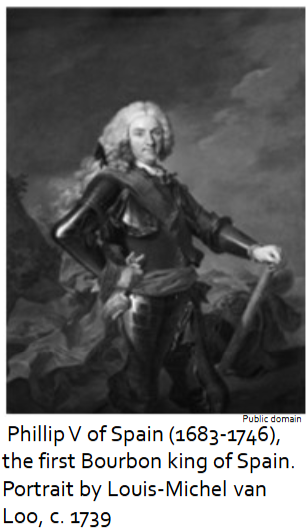
The Napoleonic Empire
• Napoleon Bonaparte—Emperor of France from 1804-1814, 1815
• In 1808, Napoleon forced the Spanish king, Charles IV, to abdicate
Placed his older brother, Joseph Bonaparte, on the throne
Extremely unpopular, Joseph’s arrival sparked the Peninsular War
Abdicated and returned to France in 1813
• Weakness of Spanish rule during this period sparked independence movements throughout Latin America (1810- 1825)
Joseph Bonaparte
• In 1808, Napoleon forced the Spanish king, Charles IV, to abdicate
• Placed his older brother, Joseph Bonaparte, on the throne
Extremely unpopular, Joseph’s arrival sparked the Peninsular War
Abdicated and returned to France in 1813
• Weakness of Spanish rule during this period sparked independence movements throughout Latin America (1810- 1825)
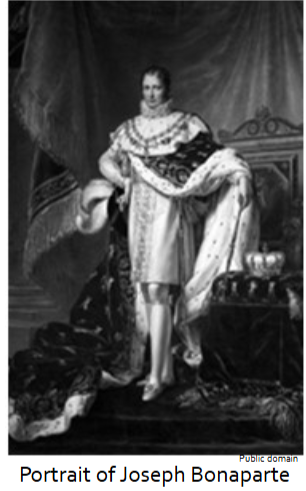
The Peninsular War
Extremely unpopular, Joseph’s arrival sparked the Peninsular War
Abdicated and returned to France in 1813
• Weakness of Spanish rule during this period sparked independence movements throughout Latin America (1810- 1825)
The Mexican War of Independence, 1808-1821
• In September 1808 peninsular-born Spaniards in New Spain overthrew the rule of Viceroy José de Iturrigaray (1803–08)
• Imprisoned, and a member of the rebel faction was made viceroy
The event radicalized both sides
• In 1810, the Hidalgo revolt marked the beginning of military conflict
The Spanish colonial regime did not expect the extent of the uprising
Organized and led by Spanish-American creole leaders and intellectuals
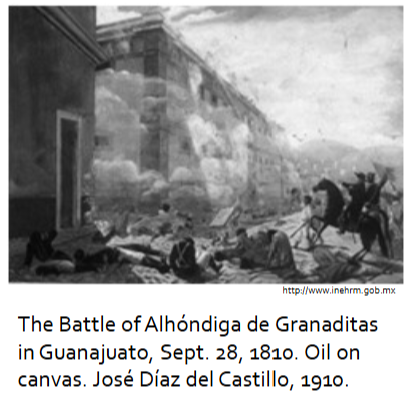
Miguel Hidalgo
Important leaders of the Mexican War of Independence
• Miguel Hidalgo (1810–11)
Spanish priest and university priest—his speech, the “Cry of Dolores” began the Hidalgo Revolt
Gathered an army of 90,000 farmers, including many of indigenous, mestizo, and Afro-Indigenous heritage
Defeated at the Battle of Calderón Bridge; captured and executed
The “Cry of Dolores”
• Miguel Hidalgo (1810–11)
Spanish priest and university priest—his speech, the “Cry of Dolores” began the Hidalgo Revolt
The Hidalgo revolt
• In 1810, the Hidalgo revolt marked the beginning of military conflict
The Spanish colonial regime did not expect the extent of the uprising
Organized and led by Spanish-American creole leaders and intellectuals
hidalgo revolt started by Manuel Hidalgo’s speech the “cry of dolores”
Vicente Guerrero
Important leaders of the Mexican War of Independence
• Vicente Guerrero (1810–21)
• From Guerrero, of African and Indigenous descent
• Won many victories in southern Mexico
• Allied with Iturbide to form the Plan de Iguala, to abolish the caste system
Guadalupe Victoria
Important leaders of the Mexican War of Independence
• Guadalupe Victoria (1812–21)
From Durango, in northern Mexico
Participated in the Assault of Oaxaca (huge victory for the rebels)
Commander of the rebel army in Veracruz
Agustín de Iturbide
Important leaders of the Mexican War of Independence
• Agustín de Iturbide (1821)
His father was a nobleman from Spain and his mother was Creole; born in Michoacan
Originally a commander in the royalist army, gained the rank of colonel
By 1820, he became convinced of the necessity of a Mexican independence movement, and secretly negotiated with Guerrero
Army of the Three Guarantees
• In 1821, Iturbide, Guerrero and Victoria joined forces to create the “Army of the Three Guarantees”
• Proposed the “Plan of Iguala,”
Stated that if a member of the Bourbon family did not come to Mexico to rule, Mexico would have the right to elect a ruler by its own people
Also proposed eliminating the caste system and abolishing slavery
Became the Treaty of Córdoba (1821)
• Iturbide was named President of the Provisional Governing Junta
In the meantime, Spain rejected the Treaty of Cordoba
Iturbide was then elected the Emperor of Mexico (maybe a coup?)
However, the new Congress refused to re-draw the constitution
The Mexican elite initially supported him, but turned against him when he imposed a 40% property tax
Plan of Iguala
• In 1821, Iturbide, Guerrero and Victoria joined forces to create the “Army of the Three Guarantees”
• Proposed the “Plan of Iguala,”
Stated that if a member of the Bourbon family did not come to Mexico to rule, Mexico would have the right to elect a ruler by its own people
Also proposed eliminating the caste system and abolishing slavery
Became the Treaty of Córdoba (1821)
Treaty of Córdoba
• In 1821, Iturbide, Guerrero and Victoria joined forces to create the “Army of the Three Guarantees”
• Proposed the “Plan of Iguala,”
Stated that if a member of the Bourbon family did not come to Mexico to rule, Mexico would have the right to elect a ruler by its own people
Also proposed eliminating the caste system and abolishing slavery
Became the Treaty of Córdoba (1821)
Iturbide as Emperor of Mexico
• Iturbide was named President of the Provisional Governing Junta
In the meantime, Spain rejected the Treaty of Cordoba
Iturbide was then elected the Emperor of Mexico (maybe a coup?)
However, the new Congress refused to re-draw the constitution
The Mexican elite initially supported him, but turned against him when he imposed a 40% property tax
General Santa Anna
• In 1822, General Santa Anna publically opposed Iturbide
Joined by Guadalupe Victoria and Vincente Guerrero
Intense fighting in Veracruz
Formed the Plan of Casa Mata
Called for the establishment of a Mexican Republic, the installation of a new Congress and declared Iturbide’s election null and void
• Santa Anna’s troops marched to Mexico City; as they approached, Iturbide abdicated, and was exiled to Italy
He returned to Mexico in 1824, and was executed by firing squad
• Also in 1823, Guatemala, El Salvador, Nicaragua, Costa Rica and Honduras convened a Congress to declare themselves the United Provinces of Central America, independent from Spain and Mexico
United Provinces of Central America
• Also in 1823, Guatemala, El Salvador, Nicaragua, Costa Rica and Honduras convened a Congress to declare themselves the United Provinces of Central America, independent from Spain and Mexico
Constitution of 1824
• After the adoption of the Constitution of 1824,
Guadalupe Victoria was elected as the first President of
the United Mexican States
• Secured international recognition of Mexico’s
independence
After serving his term, he became President of the Senate
• After the revolution, Vincente Guerrero briefly became president through a coup in 1828
He himself was overthrown in a coup in 1829, and was tried and executed for treason
“Plan de Chiapas Libre”
Brief Independence for Chiapas
• In 1821, the provincial assembly of Chiapas declared its independence from Spain and Guatemala, and joined the Empire of Mexico under Iturbide
• However, after the abdication of Iturbide, it declared its independence, under the “Plan de Chiapas Libre” (Plan of Free Chiapas), which it maintained from 1821-1823.
Ruled by a Supreme Provisional Board
• After 1824, a popular vote was taken, and the voters decided to join Mexico.
Liberal reforms and backlash
• After the War of Independence, despite official abolition of the caste system, the Peninsular and Creole elites retained control over land, army and church
Based in Colonial cities and provincial capitals
• Oscillation between Centralists and Federalists (called Conservatives and Liberals by the 1850s)
Centralists were conservative, favoring the church, miliary, and traditional elites
Federalists favored land reform, public education, and separation of church and state
• Both had the effect of concentrating wealth in urban centers and port cities
Centralists vs. Federalists
in Liberal reforms and backlash
Oscillation between Centralists and Federalists (called Conservatives and Liberals by the 1850s)
Centralists were conservative, favoring the church, miliary, and traditional elites
Federalists favored land reform, public education, and separation of church and state
The Caudillo System
• Despite having republican constitutions, politics at the national and local levels favored Caudillos (“strongmen”)
Roots in Colonial systems of hierarchy
Rule through the support of the military
Extreme patronage systems and reciprocity networks
Ambitious mestizos could intermarry with the creole elite to advance
Liberals vs. Conservatives
• In the 1830s and 40s, liberals viewed the church as necessary for the social order of the state.
• However, in the 1850s, the church actively opposed Liberal’s attempts to reform social institutions and land reform
Slogan of “Religion y fueros”—fueros were the legal privileges of the church and army
• During the Colonial period, the church had slowly become one of the largest landowning institutions, and also received numerous legal and financial exemptions
• As a result, Liberals started to oppose the amassed wealth of the Church, and the legal exemptions that the Church received, as part of their platform for reform (La Reforma)
Influenced by the political thought of the American and French Revolutions
Religion y Fueros
in Liberals vs. Conservatives
• In the 1830s and 40s, liberals viewed the church as necessary for the social order of the state.
• However, in the 1850s, the church actively opposed Liberal’s attempts to reform social institutions and land reform
Slogan of “Religion y fueros”—fueros were the legal privileges of the church and army
Liberal Reforms (La Reforma)
in liberals vs. conservatives
• During the Colonial period, the church had slowly become one of the largest landowning institutions, and also received numerous legal and financial exemptions
• As a result, Liberals started to oppose the amassed wealth of the Church, and the legal exemptions that the Church received, as part of their platform for reform (La Reforma)
Influenced by the political thought of the American and French Revolutions
Liberal reforms and indigenous groups
• For most of the 19th century, creoles maintained political and economic power
• In Mexico, mestizos made some gains, as the symbol of Independent Mexico under the Porfirio Diaz dictatorship
• In Central America, mestizos (called Ladinos) found it harder to gain recognition
• Indigenous people were generally considered “backwards” and in need of assimilation by both creoles and mestizos
• Liberal reforms focused on forcing indigenous communities to adopt Spanish language, practice orthodox Catholicism, work for wages, and emulate Western culture
• In many ways, Liberal reforms damaged Indigenous communities even more than Spanish colonialism
• Under Spanish colonialism, systems of rural communities and customary laws remained intact, as long as tribute was paid
• Under Liberal reforms, some Indigenous communities lost nearly half of their best agricultural land
• Indigenous municipal authorities were replaced with creoles or mestizos
• Rather than paying tribute in goods, they were often forced to pay in metal coinage
• Many entered wage labor/debt peonage
• Many revolts broke out, but few policy changes were made
Economic developments
• Many Mesoamerican elites were strongly influenced by French positivism
Mesoamerican countries were “behind” Europe, and needed to “catch up” by modeling themselves on Europe
Promoted capitalism and industrialization
Promoted production for international export markets
Promoted science, reason, and secularization
• This resulted in exclusion and oppression for Indigenous people and mestizos
Early US Meddling
• The Monroe Doctrine, 1823—by US President James Monroe, warned European powers not to interfere in the affairs of the Western Hemisphere, as it was the United States' sphere of interest
• The US meddled many times in Mexican independence, encouraging them to throw off Spanish rule, then maneuvering to gain trade monopolies
• Annexation of Texas in 1845
• Mexican-American war in 1846-1848
In 1846, the US invaded and occupied Mexico City
Forced the Mexican Government to cede its northern territories in the Treaty of Guadalupe Hidalgo
• Senator William Walker from California invaded Nicaragua in 1855 and ruled it as a slave state for two years
Benito Juárez
Liberal reforms in Mexico
•Benito Juárez (president 1852 to 1872*)
•Born in Oaxaca to an elite Zapotec family
• First person of Indigenous background to be governor and/or president
• Studied law, became Governor of Oaxaca, then head justice of the Supreme Court, then President
• As governor, he began a campaign for liberal reforms
Separation of Church and State
Confiscation of Church lands
Abolition of religious orders
Removal of the church from education and the establishment of public schools
Establishment of civil registration for births, marriages and deaths
The Liberal Constitution of 1857 and the Juárez Law
• In 1855, The Juárez Law was passed as part of the Constitution of 1857
• Benito Juarez was a known liberal reform leader, but was not yet president
• Took away the special privileges of the Catholic Church and the military
• Stated that members of the clergy and military were subject to the common law and the
jurisdiction of the civil courts
• Established the equality of all Mexican citizens under the law
• Followed quickly by the Lerdo Law of 1856
• Confiscated all Church land that was not used for religious purposes
• Forbid collective land-holding, forcing the church to sell the majority of its lands.
• However, Indigenous communities also had collective landholdings, which they were
forced to sell, creating fierce resistance
The Reform War
The Reform War, 1858-1860
• Sparked by two coups led by Conservative general Felix Zuloaga
• As a result, the liberal president, Ignacio Comonfort, resigned; as head of the
Supreme Court, Benito Juarez becomes president
• Different Mexican states took sides in the civil war; the US supported the Liberals, and the UK, Spain and France supported the Conservatives
• The Liberals won; Conservative forces surrendered in Dec. 1860.
Conservative guerilla forces remained active in rural areas following the war
• As a result of the war, Mexico’s infrastructure and finances are left in ruins
• Mexico is deeply in debt to European powers
In 1861, the Convention of London (treaty) is signed by the United Kingdom, Spain, and France to agree on the course of action to obtain loan repayments from Mexico
The French Invasion (1861-1867)
• After the war, Juarez’s liberal government suspends payment of its external debt, mostly held by the UK, France and Spain
• Almost immediately after the Reform War, the Conservatives seek help from European powers, particularly France
• The suspension of debt created a pretext for Napoleon III to invade
• French troops land in Dec. 1961, and were joined by Conservative generals.
Defeated by Liberal forces at the Battle of Puebla on May 5th, 1862 (Cinco de Mayo)
The French forces regrouped and took control of Mexico City in June 1863
They appoint a committee to select 250 Mexican citizens to form an Assembly of Notables (Junta Superior)
The Assembly decides to invite Ferdinand Maximillian von Hapsburg, the brother of Emperor Franz Joseph of Austria, to be their Emperor and establish a monarchy
The Battle of Puebla
in the french invasion
• French troops land in Dec. 1961, and were joined by Conservative generals.
Defeated by Liberal forces at the Battle of Puebla on May 5th, 1862 (Cinco de Mayo)
The French forces regrouped and took control of Mexico City in June 1863
They appoint a committee to select 250 Mexican citizens to form an Assembly of Notables (Junta Superior)
The Assembly decides to invite Ferdinand Maximillian von Hapsburg, the brother of Emperor Franz Joseph of Austria, to be their Emperor and establish a monarchy
Cinco de Mayo
• French troops land in Dec. 1961, and were joined by Conservative generals.
Defeated by Liberal forces at the Battle of Puebla on May 5th, 1862 (Cinco de Mayo)
Emperor Ferdinand Maximillian von Hapsburg
Emperor Maximillian in Mexico
• In 1864, Maximillian accepts the crown, and arrives in Mexico
• Maximillian was also fairly liberal, and while he maintained Catholicism as the state religion, he kept many of the Reform Laws intact
Alienated many Conservative and church supporters
• Promotes railroad construction, banking, forest management, patronage of artists, and labor laws, and published laws in both Spanish and Nahuatl.
• Meanwhile:
The US government refused to recognize Maximillian’s government, and put diplomatic pressure on France to leave Mexico
Liberal guerilla forces continue to attack rural areas
Maximillian signs the “Black Decree” authorizing court martial and execution of anyone aiding or participating with the guerillas—makes him even more unpopular
Maximillian’s reforms
• Maximillian was also fairly liberal, and while he maintained Catholicism as the state religion, he kept many of the Reform Laws intact
Alienated many Conservative and church supporters
• Promotes railroad construction, banking, forest management, patronage of artists, and labor laws, and published laws in both Spanish and Nahuatl.
• Meanwhile:
The US government refused to recognize Maximillian’s government, and put diplomatic pressure on France to leave Mexico
Liberal guerilla forces continue to attack rural areas
Maximillian signs the “Black Decree” authorizing court martial and execution of anyone aiding or participating with the guerillas—makes him even more unpopular
The Black Degree
• Maximillian signs the “Black Decree” authorizing court martial and execution of anyone aiding or participating with the guerillas—makes him even more unpopular
The execution of Emperor Maximillian
The fall and execution of Emperor Maximillian
• In January 1866, Napoleon decides to withdraw French troops from Mexico
• Maximillian requests aid or a delay in troop withdraws, but is denied
France was anticipating a possible war with Prussia
Sent his wife, Carlotta to Europe to plead for aid, but fails to gain support
• In October, Maximillian meets with his cabinet in Orizaba, contemplating abdication, but his cabinet votes against it
• In February, the last of the French troops leave, and Maximillian goes to join his remaining Mexican military forces in Queretaro
Liberal forces of 40,000 troops surround the city
Finally, an imperial officer betrays the Emperor and opens the city gates to the Liberal army
Maximillian and his top generals are captured, placed on trial, and executed
• After the war, Benito Juarez resumes the presidency until he died of a heart attack in 1872
Economic developments under liberal reforms
Neo-Colonial cities
• Cities expanded rapidly from 1850-1900
Urban cores were filled with mansions and European-style architecture
• Development of rail systems to link agricultural plantations with cities and ports
• Many displaced Indigenous people and mestizos came to cities for wage labor opportunities
Created working-class and slum barrios in cities
Development of railroads
In neo colonial cities
• Development of rail systems to link agricultural plantations with cities and ports
The Hacienda system
• Haciendas were originally land grants to Spanish conquistadors (in tandem with the encomienda system)
• During the Liberal Century, in Yucatan, Chiapas and Guatemala, government policies favored privatization of communal land, which was sold to German immigrants and N. Am/European corporations
• Many of these new haciendas were created from appropriated communal lands or foreign purchase of former church/private lands. The new plantations and ranches often produced coffee, henequen, bananas and beef for export to the US
• Indigenous people went to work on these plantations in large numbers
• Wages were never sufficient to pay for housing and food from “company stores”
Form of debt peonage, paid with exchange tokens instead of real money
The Aké Hacienda, Yucatan
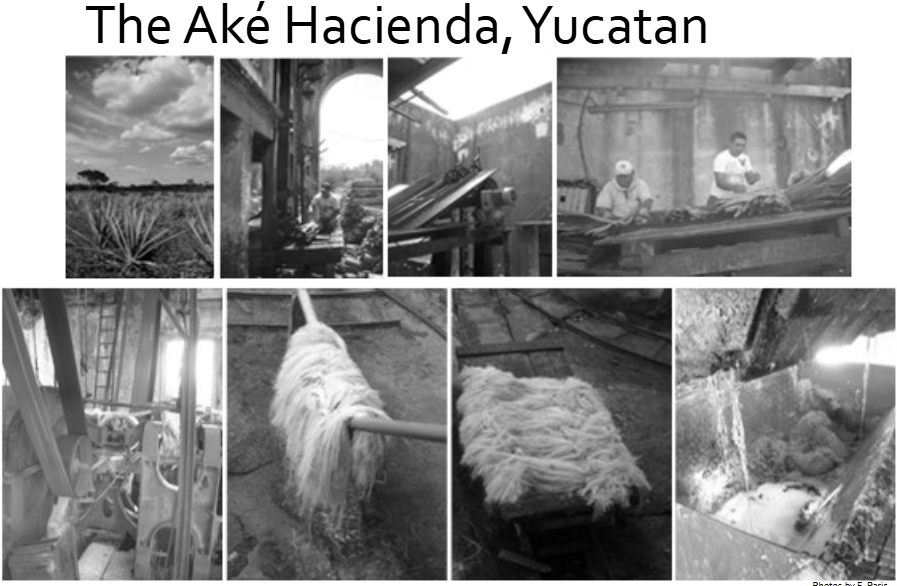
Murals by Fernando Castro Pacheco, Merida
The Caste War, 1847-1901
• Liberal caudillos of Yucatan pushed to expand the henequen and sugar cane industry, particularly in the west
• Many fled to Quintana Roo in the east, which was historically less controlled by the Spanish
• Chan Santa Cruz (today Felipe Carrillo Puerto) became the center of a Maya rebellion, beginning in 1847
The symbol of the rebellion was the “Talking Cross”
Over 100,000 Maya joined the rebellion
Drove all Spanish and creoles from Chan Santa Cruz
Proclaimed an independent “State of the Cross”
Founded new cities, established using principles of pre-Hispanic Maya cosmology
• From the late 1850s to 1893, the UK recognized the Free Maya State, because it facilitated trade through Belize
• However, in 1893, the Maya conquered Bacalar and killed British citizens along with the creole garrison
• The city of Chan Santa Cruz was finally occupied by the Mexican army in 1901
• Formal resistance continued until the signing of a peace treaty in 1935
• Talking crosses remain an important part of local culture in the eastern Yucatan
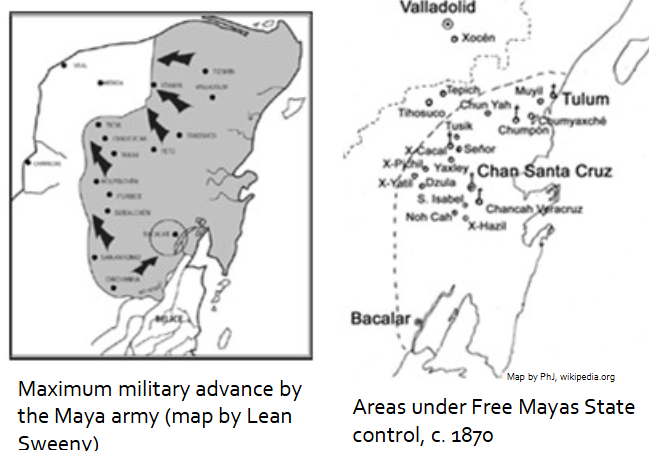
Chan Santa Cruz (today Felipe Carrillo Puerto)
• Chan Santa Cruz (today Felipe Carrillo Puerto) became the
center of a Maya rebellion, beginning in 1847
The symbol of the rebellion was the “Talking Cross”
Over 100,000 Maya joined the rebellion
Drove all Spanish and creoles from Chan Santa Cruz
Proclaimed an independent “State of the Cross”
Founded new cities, established using principles of pre-Hispanic Maya cosmology
in The Caste War, 1847-1901
Talking crosses
• Chan Santa Cruz (today Felipe Carrillo Puerto) became the center of a Maya rebellion, beginning in 1847
The symbol of the rebellion was the “Talking Cross”
The State of the Cross
• Chan Santa Cruz (today Felipe Carrillo Puerto) became the center of a Maya rebellion, beginning in 1847
The symbol of the rebellion was the “Talking Cross”
Over 100,000 Maya joined the rebellion
Drove all Spanish and creoles from Chan Santa Cruz
Proclaimed an independent “State of the Cross”
Founded new cities, established using principles of pre-Hispanic Maya cosmology
Maya slavery in Cuba
• Despite the fact that slavery had been outlawed by the Mexican War of Independence, it continued in some places
• During the Caste War, from 1848-1861, slavers promised Maya people they would have a better and freer life in Cuba
• Upon arrival, they were sold as slaves to sugarcane planters
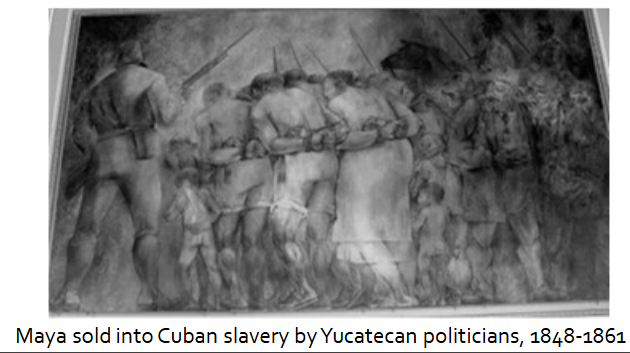
Other indigenous rebellions against liberal reform
??
Early US Meddling
• The Monroe Doctrine, 1823—by US President James Monroe, warned European powers not to interfere in the affairs of the Western Hemisphere, as it was the United States' sphere of interest
• The US meddled many times in Mexican independence, encouraging them to throw off Spanish rule, then maneuvering to gain trade monopolies
• Annexation of Texas in 1845
• Mexican-American war in 1846-1848
In 1846, the US invaded and occupied Mexico City
Forced the Mexican Government to cede its northern territories in the Treaty of Guadalupe Hidalgo
• Senator William Walker from California invaded Nicaragua in 1855 and ruled it as a slave state for two years
The Monroe Doctrine
Early US Meddling
• The Monroe Doctrine, 1823—by US President James Monroe, warned European powers not to interfere in the affairs of the Western Hemisphere, as it was the United States' sphere of interest
Annexation of Texas by the USA in 1845
Early US Meddling
• Annexation of Texas in 1845
• Mexican-American war in 1846-1848
In 1846, the US invaded and occupied Mexico City
Forced the Mexican Government to cede its northern territories in the Treaty of Guadalupe Hidalgo
Mexican-American war in 1846-1848
Early US Meddling
• Mexican-American war in 1846-1848
In 1846, the US invaded and occupied Mexico City
Forced the Mexican Government to cede its northern territories in the Treaty of Guadalupe Hidalgo
Treaty of Guadalupe Hidalgo
Early US Meddling
• Mexican-American war in 1846-1848
In 1846, the US invaded and occupied Mexico City
Forced the Mexican Government to cede its northern territories in the Treaty of Guadalupe Hidalgo
Porfirio Díaz
• Porfirio Díaz—president/dictator of Mexico from 1877-
1880 and 1884-1911
The Porfiriato
• Porfirio Díaz—president/dictator of Mexico from 1877- 1880 and 1884-1911
• His mother was Indigenous Mixteca and his father was a working-class creole—embodied “mestisaje” and caudillo politics
• Liberal reformer who glorified European-style modernization
• Harsh policies towards Indigenous people—military action against Indigenous rebellions
Banana Republics
• During the 1870’s, Porfirio Díaz made it legal for US citizens to own property in Mexico
• He established open-door economic policies, allowing US investors to gain control over mining, oil production, railways and export agriculture
By 1911, Mexico was the 2nd largest silver producer in the world
• “Keeper of the company store”
• From apx. 1905-1920, the US interfered in most Central American countries’ politics—appointing and removing dictators, mostly in order to secure banana and oil interests
United Fruit Company
Panama Canal, 1903-1914
• By 1921, 70% of Mexican oil production was US-owned
• US companies owned and operated most major industries, including sugarcane, henequen, mining, and the railroad industry
• Between mining and agriculture, foreign investors owned almost 20% of Mexico’s total land surface